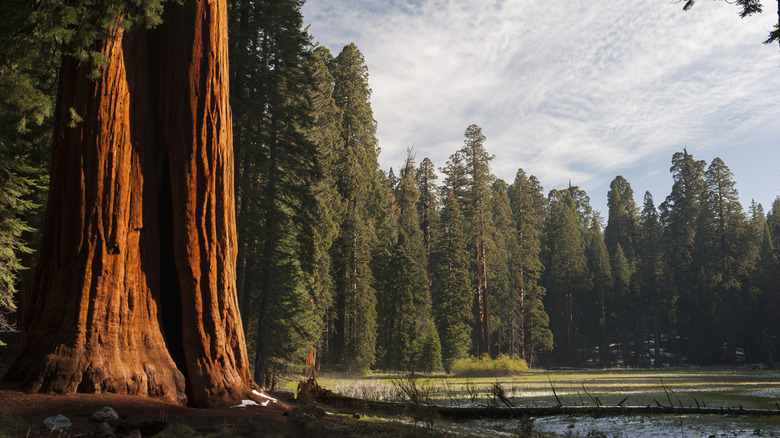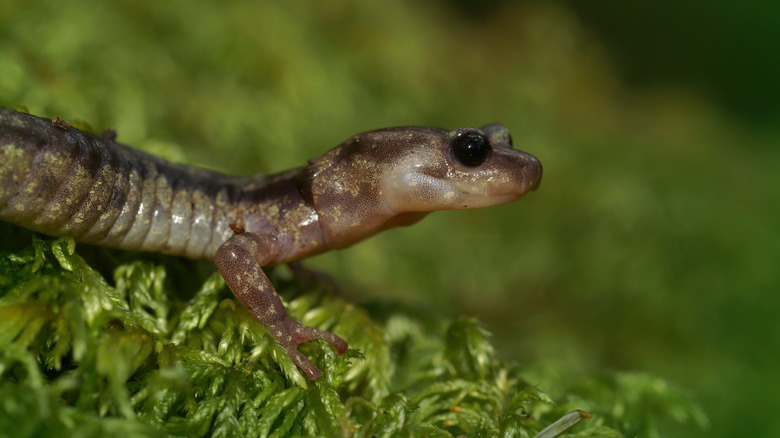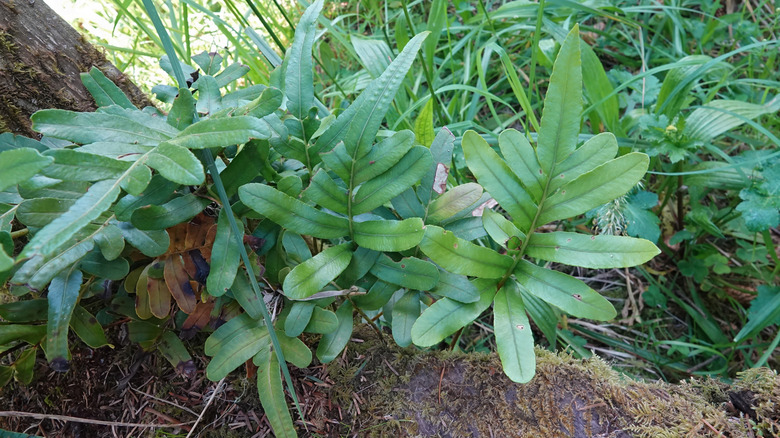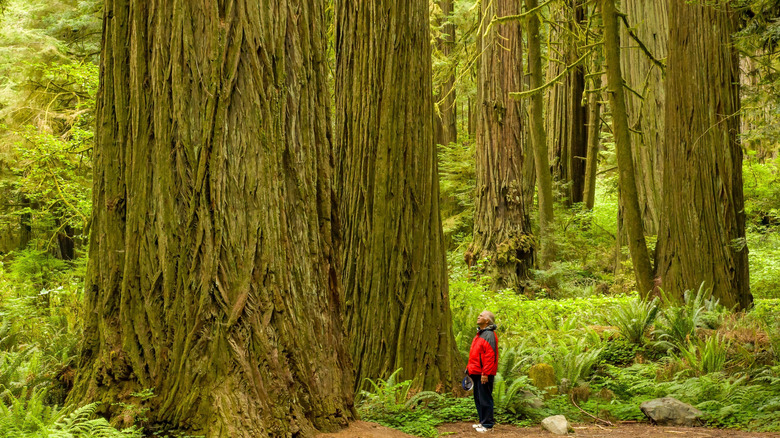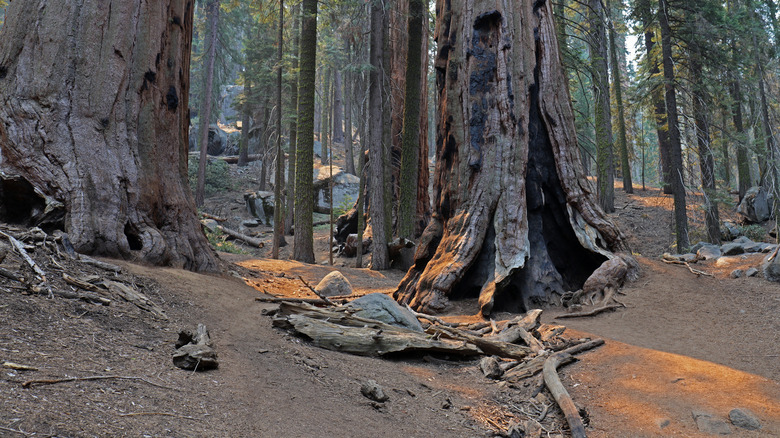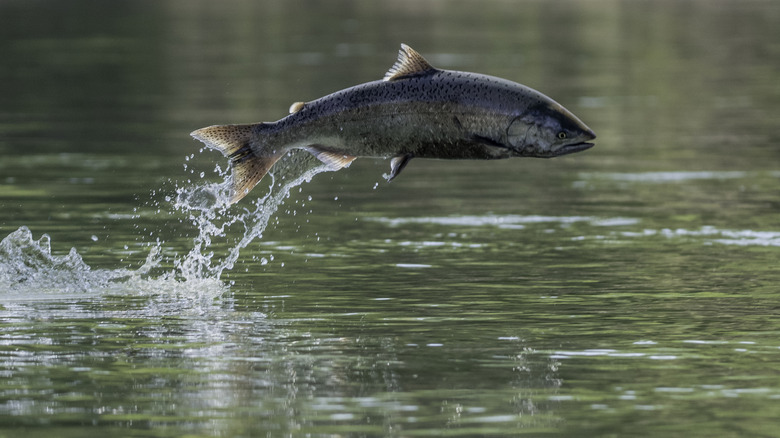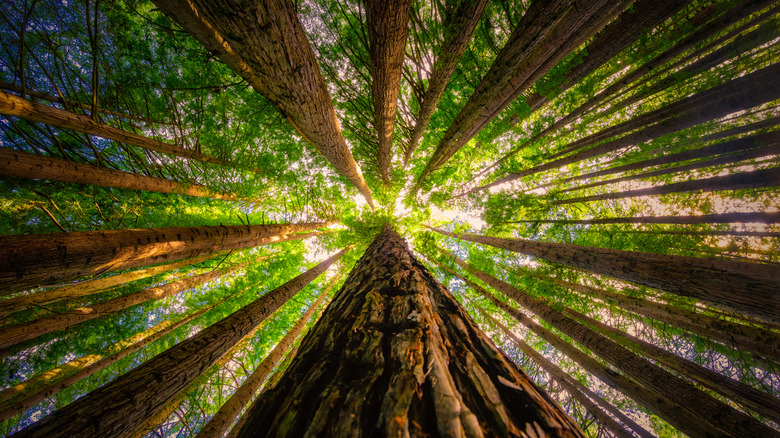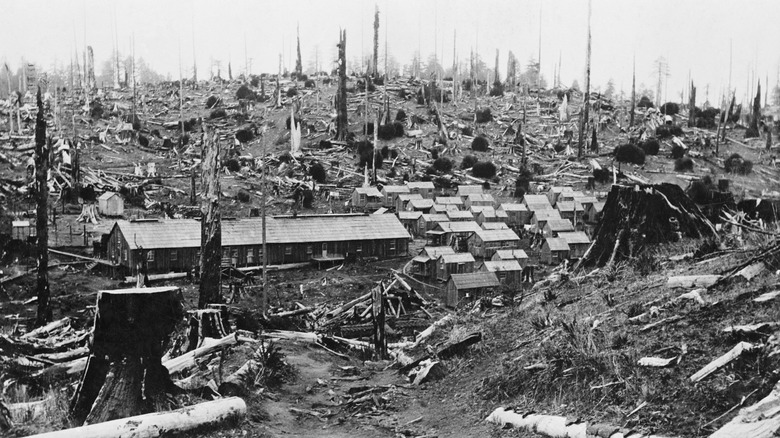The 7 Most Unusual Facts About California Redwoods
Nothing quite compares to the majesty of a towering redwood tree. These forest giants have inspired generations of artists, from Albert Bierstadt and his sweeping portraits of the American West to the creators of "Star Wars," who sent Luke Skywalker speeding through a forest of redwoods in "Return of the Jedi." The National Park Service even features a redwood tree in its logo, honoring it as one of the country's great natural treasures.
Redwood trees aren't exclusive to America. There is a species called the dawn redwood (Metasequoia glyptostroboides), which grows in Central China; however, it is by far the smallest of the family, and bears little resemblance to the ones captured on canvas and screen. The great giants we associate with redwoods belong to the other two species: the giant sequoia (Sequoiadendron giganteum) and coast redwood (Sequoia sempervirens), both of which can top 300 feet in height. With the exception of a small region of coast redwoods in Southern Oregon, these species are exclusively found in the state of California.
Redwoods are best known for their incredible height and longevity. The tallest living tree in the world is a coast redwood nicknamed Hyperion, which stands just over 380 feet within Redwood National Park. The largest living tree by volume is also a redwood: a giant sequoia known as General Sherman, located in Sequoia National Park. Both giant sequoias and coast redwoods can live over 2,000 years, explaining their growth. However, height and age records aren't even the most interesting thing about California's redwoods.
Redwoods host many species in their branches
Redwoods are a vital part of the forest ecosystem at large, but each tree also hosts a microcosm of life high in its branches. This includes many animals that you would expect to find in trees, such as nesting birds. One such bird is the marbled murrelet (Brachyramphus marmoratus), which uses the high branches of redwood trees as a safe haven for their eggs. These birds are endangered and have a low reproductive rate, making the long-term health of redwood forests essential to their odds of recovery.
Another endangered bird that makes its home in redwood trees is the northern spotted owl (Strix occidentalis caurina). Rather than building their own nests from scratch, they rely on naturally occurring hollows in the tree trunks to find a safe place for their eggs.
Redwoods also host species that you might be surprised to find in a tree, such as amphibians like the wandering salamander (Aneides vagrans). This amphibian has captivated the scientific community because it appears to glide between tree branches, despite not having the wing-like membranes observed in other gliding lizards and flying squirrels. Only recently, with the aid of slow-motion cameras, have researchers discovered that wandering salamanders are able to control their speed and direction while in midair by using their long limbs and tails, essentially gliding in the form of a carefully controlled fall.
Other plants can grow on redwood trees
Animals aren't the only life thriving high in the branches of redwood trees. Much like there are plants in the canopy layer of rainforests, there are also numerous plant species in redwood canopies, and how they grow there is pretty astounding. Redwoods are constantly shedding their leaves and growing new ones, so over time, large quantities of dead leaves collect on the branches. Over the centuries of a redwood tree's life, these dead leaves break down to form mats of soil hundreds of feet above the ground. These soil layers can be as much as 3 feet deep, allowing other plants to take root in the redwood canopy.
Plants that grow on other plants are known as epiphytes, and there are over 200 species of them found in redwoods. These include mosses, berries, and even other types of trees, such as Sitka spruce and western hemlock, but the most important epiphyte of the redwood tree is Polypodium scouleri, the leather-leaf fern. Growing in the soil on redwood branches, these ferns form mats that can be up to 8 feet wide, providing a home for the wandering salamander and the many insects it feeds on. The fern mats also do a service to the redwood trees themselves. Fern mats absorb rainwater, holding up to 5,000 gallons per acre, which the redwoods and their epiphytes can use as reservoirs. Redwood trees even grow extra roots from their branches to tap into the water held in fern mats.
The coast redwood has one of the largest genomes ever sequenced
Plants might not seem as complex as animals when you first consider them, but the coast redwood's genome is almost nine times larger than that of a human. The Redwood Genome Project was launched by a collective of scientists and conservationists with the aim of unlocking the secrets to the massive trees' height and longevity. Completed in 2021, the project revealed that the coast redwood genome contains 26.5 billion base pairs of DNA (referring to the four nitrogenous bases of DNA), while the human genome only contains three billion. Even more notable is the fact that coast redwoods have six sets of chromosomes, compared to the two sets found not only in humans, but also in the coast redwood's cousin, the giant sequoia.
The Redwood Genome Project led scientists to determine that coast redwoods did not originate as a hybrid of other tree species, but rather evolved linearly from a single ancestor far in the past, with the coast redwood containing hundreds of unique genes not found in any other conifer. These include genes responsible for stress response, which explain how coast redwoods are able to resist fungal diseases and physical damage. Researchers also identified genes involved in drought resistance, which could play a crucial role in reviving redwood forests threatened by logging and climate change.
Giant sequoias reproduce with help from forest fires
Typically speaking, flames are bad news for trees, but giant sequoias can't survive without wildfires. Fire burns through the forest undergrowth, clearing away dead plant material to make space where new trees can grow. This also exposes the mineral-rich soil of the forest floor, which the seeds need in order to germinate. Speaking of seeds, the sequoias couldn't even release theirs if it wasn't for the help of wildfires.
Redwoods are conifers, meaning they are one of the types of trees that have cones. These cones contain the trees' seeds, with a single giant sequoia cone holding 200 seeds on average. These seeds remain locked in their cones, and can only be released if acted upon by an outside force. That's where fire comes into play. The high heat of a wildfire causes the cones of the giant sequoia to open, spilling their seeds on the forest floor.
Giant sequoias are able to survive this way because they are extremely fire-resistant compared to other trees. Their bark can be up to 2 feet thick, forming a powerful insulator to protect the heart of the tree. However, sequoias need time to heal after each blaze, and they are only meant to withstand naturally occurring wildfires, which have historically happened every one to three decades. With wildfires becoming more frequent and intense due to human activities, the tenacity of the giant sequoia is being pushed to its limit.
Redwoods have a symbiotic relationship with salmon
Redwood trees have a special relationship with what is perhaps North America's most beloved fish, the salmon. Redwoods can be found along several of the most important waterways in Northern California, including the Klamath and Smith Rivers, which salmon and other fish such as steelhead trout traverse to reach their spawning grounds. Many of the creeks within the Redwood National and State Parks system are also used by spawning salmon, and the trees and fish are more than neighbors; they are essential to each other's survival.
Redwood trees help to maintain the natural waterways salmon use to spawn, with their roots keeping riverbanks from eroding. Their towering canopies also provide shade that keeps the water at the cooler temperatures that salmon prefer. Even more remarkable is the service salmon provide to redwoods in return. When salmon travel upstream to spawn, they carry in their bodies countless nutrients accumulated through their lives at sea. When spawning salmon die, their bodies decompose in the riverbeds, filling the local soil with ocean-derived nutrients that they could not access any other way. Maintaining a healthy redwood population requires a healthy salmon population, and vice-versa.
Redwoods capture more carbon emissions than any other tree
Greenhouse gases released by human industry have been the main factor driving climate change. Of all these gases, the one that accounts for the largest amount of global warming is carbon dioxide, atmospheric levels of which have risen dramatically through the burning of fossil fuels. Plants absorb carbon dioxide through photosynthesis, and are therefore perhaps the most important soldiers in the fight against climate change. Trees absorb more carbon dioxide than other plants on average because they can store great amounts of carbon in their trunks. As the tallest and largest tree species, coast redwoods and giant sequoias capture more carbon emissions than any other trees on Earth.
Redwoods are incredible carbon sequesters not only because of their height, but also their longevity, creating long-term storage for huge amounts of carbon. However, logging, as well as damage to the trees done by wildfires, causes stored carbon to be re-released into the atmosphere, making the long-term health of redwood forests absolutely essential to the future of the planet. Unfortunately, the redwood forests of today are but a small fraction of what they were at their height, and sadly, both species of California redwoods are currently endangered.
Redwoods were almost wiped out by logging
Prior to the aggressive westward expansion of the United States in the mid-1800s, there were roughly 2 million acres of redwood trees in Northern California. These were primarily "old growth" redwoods, a term that refers to trees that have developed certain features associated with age, particularly hard, resilient bark and scars from wildfires. When Euro-Americans began settling the region in the wake of California's gold rush, logging became the primary industry of the Pacific Northwest, and no tree was more prized for its lumber than the ultra-hardy redwood. Over the next century, logging eliminated an estimated 95% of all old-growth redwood trees.
The IUCN Red List includes both the coast redwood and giant sequoia as endangered species, numbers of which are still decreasing. However, valiant efforts are being made to preserve and regrow Northern California's redwood forests. The turning point came in 1968, when the United States government purchased almost 60,000 acres of land from timber companies and established Redwoods National Park. Today, the park covers over 130,000 acres, with nearly 40,000 of them comprising old-growth redwoods.
Redwoods National Park has also partnered with conservationists to plant new redwood trees. Young trees aren't as hardy as the old-growth, but by mimicking environmental stressors through controlled fires and selective cutting, crews have managed to strengthen these newbies at an impressive rate, laying the groundwork for new forests of old-growth trees for the centuries to come.
